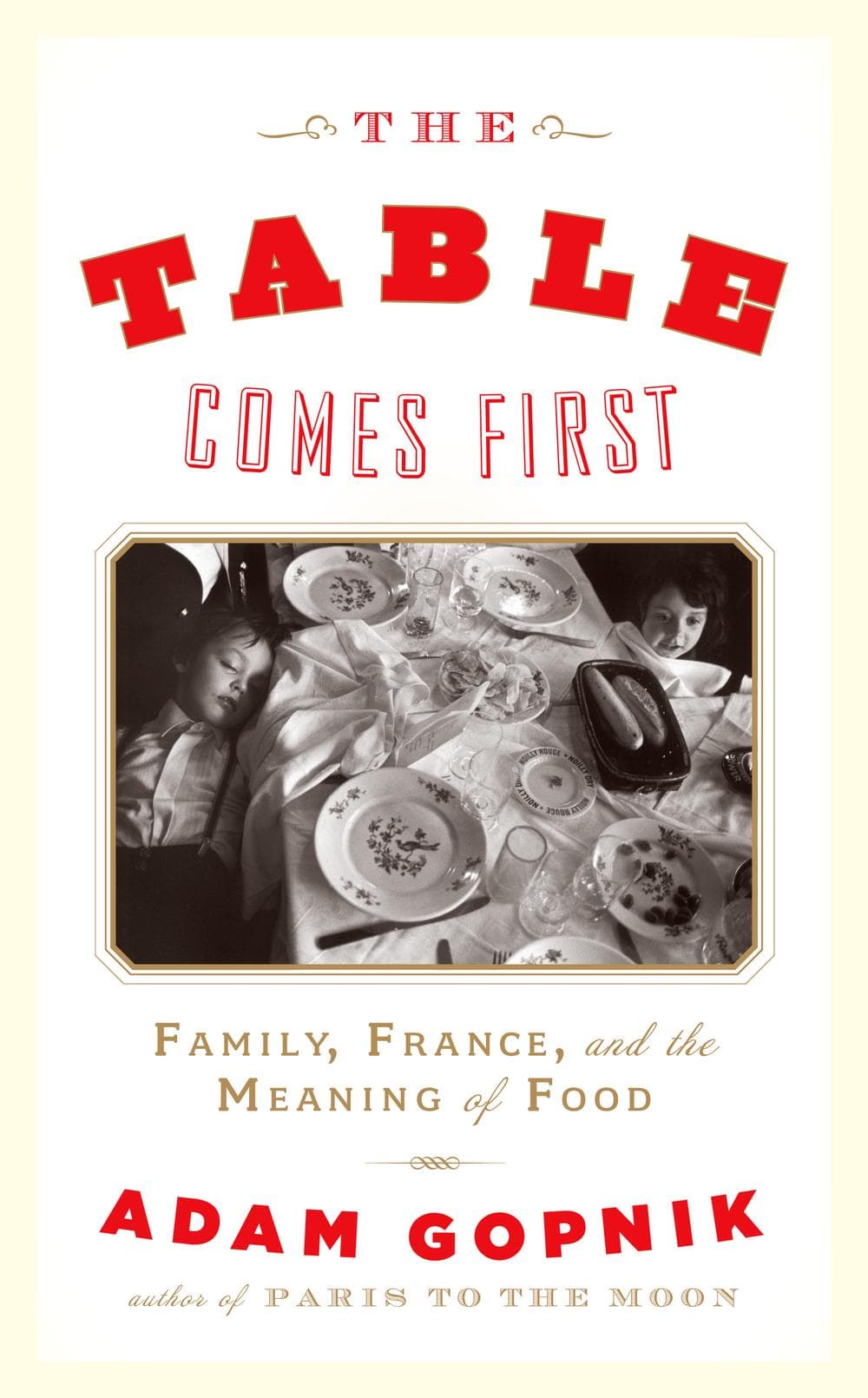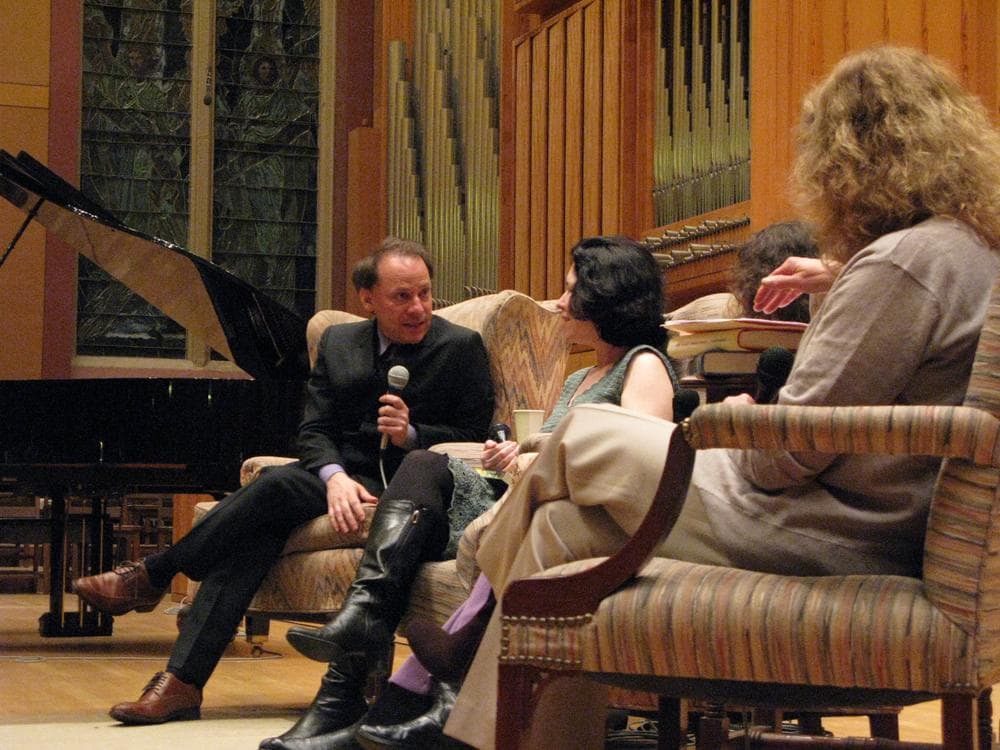Advertisement
New Yorker Writer Adam Gopnik Explores Our History With Food
Resume
What do French philosophy, Keith Richards' guitar, and science have to do with how we eat?
Quite a bit, according to New Yorker staff writer Adam Gopnik.
Gopnik weaves a narrative of how food intersects with everything from French history to the Twilight series in his new book, "The Table Comes First: Family, France, and the Meaning of Food."
Gopnik explores the glories of French cuisine, even though he says it is fading from the forefront of the food world.
He also examines the movements that will replace it — including Spain's molecular gastronomy and the bastions of the local food movement. And throughout the book he ponders the significance of food in our lives.
Book Excerpt: "The Table Comes First: Family, France, and the Meaning of Food"
By: Adam Gopnik
Who Made the Restaurant?
 A restaurant is a place where you go to eat. You usually arrive in the early afternoon or the middle of the evening, and you are taken to a table of your own in a room, usually on the ground floor of a city building in a space leased by a cook and made to look like a dining room. There are plush chairs and benches, and often mirrors. Someone, a professional go-between, often dressed in a parody of evening wear, whatever the hour, brings you a card that lists the things the cook is ready to cook, and how much it will cost to get him to cook them for you. You study this card-usually a list with decorations, sometimes bound in a leather pseudobook-and say what you'll have, and then the go-between goes into another room, the kitchen, which you can't see or hear or probably even smell. After a wait, the go-between brings the food you asked for. Very often, you will start with soup before having some grilled or roasted meat, followed by a sweet, almost always something made with sugar, a pudding or cake, rather than something naturally sweet, such as a plain piece of fruit. You are expected to have tea or coffee afterward, and then a bill is brought to your table. Prices are never mentioned out loud, and you pay whatever the card said you would. The place isn't a whorehouse or anything like it, but often you take someone there because you would like to have sex with them afterward, and sometimes you do, although, if you do, you go and do it somewhere else.
A restaurant is a place where you go to eat. You usually arrive in the early afternoon or the middle of the evening, and you are taken to a table of your own in a room, usually on the ground floor of a city building in a space leased by a cook and made to look like a dining room. There are plush chairs and benches, and often mirrors. Someone, a professional go-between, often dressed in a parody of evening wear, whatever the hour, brings you a card that lists the things the cook is ready to cook, and how much it will cost to get him to cook them for you. You study this card-usually a list with decorations, sometimes bound in a leather pseudobook-and say what you'll have, and then the go-between goes into another room, the kitchen, which you can't see or hear or probably even smell. After a wait, the go-between brings the food you asked for. Very often, you will start with soup before having some grilled or roasted meat, followed by a sweet, almost always something made with sugar, a pudding or cake, rather than something naturally sweet, such as a plain piece of fruit. You are expected to have tea or coffee afterward, and then a bill is brought to your table. Prices are never mentioned out loud, and you pay whatever the card said you would. The place isn't a whorehouse or anything like it, but often you take someone there because you would like to have sex with them afterward, and sometimes you do, although, if you do, you go and do it somewhere else.All the details, from soup to sex, of this setup, which by now seems as normal as eating itself, as obvious as breathing, can be found in more or less the same form from Sydney to San Francisco. And all of them-waiters, menus, tables, mirrors, closed kitchen, seduction, and silences, even the little table in the corner, tout compris-were thought up in Paris during a twenty-five or ten-year period right before the French Revolution and in the twenty or so years after. When you consider that eating is one of the few things that humans did even before they were people, it seems strange that restaurants should be so recent, but they are-as though the idea of having sex in beds had been discovered in Berlin during the winter of 1857, and then word got around.
There were places where you could go and pay for a meal before there were restaurants, of course: the tavern, the cookshop, the inn, the table d'hôte, the traiteur, or cook-caterer. The tavern as it evolved throughout Europe in the later part of the eighteenth century had many of the essential emotional traits of the modern restaurant. But the restaurant, with its special rituals and its particular look, began at one time and in one place.

The restaurant was known at once to be a modern and amazing thing. The great gastronome Jean Anthelme Brillat-Savarin marveled in 1825 that now "any man with three or four pistoles in his purse, can immediately, infallibly, and simply for the asking procure all the pleasures of which taste is susceptible." Yet how resilient, many- sided, adaptable, this new thing turned out to be, defying the rule that a picnic is made for one lawn and no other! If the restaurant is not the most original of modern instances and institutions, it is surely the most tenacious. It is the primal scene of modern life. Most modern urban people mark their lives by their moments in cafés and restaurants, just as ancient people marked their time on earth by visits to the local oracle, or medieval people by pilgrimages: we are courted, spurned, recruited, hired, fired, lured to a new job, or released from an old one at a table while a waiter hovers nearby. There are few marriages that did not begin at dinner at a table leased for the evening, and few divorces that did not first show signs of approaching doom in a sigh of resentment or an eye roll of exasperation in a similar setting. ("Can't you just make up your mind and stick with it?/Why do you always overtip?"...The "forever" sentiments of anniversary dinners out not rarely sugar over the approaching "no-mores" of domestic life.)
I love restaurants. I love them even though, after many years as a reporter spent being fully disillusioned about their behind-the-scenes- having labored once or twice in their kitchens and befriended their owners-I am aware of how brutal the work is, how long the hours are, and how, aside from the ventures of a handful of those entrepreneurs essentially indifferent to the food they serve, how tiny is the hope of profit. "Sale métier," the cooks and waiters alike mutter in Ludwig Bemelmans' memoirs of restaurant life in prewar Europe-"Filthy occupation"-and the muttering goes on still. Yet when I think of happy moments, I think of eating out.

Though they sometimes witness the ends of our love lives, restaurants surely have a ring of hope about them, a note of innocent celebration that makes them the right background for seduction. The man who asks the girl to dinner is not, after all, actually suggesting sex except by the airiest remote inference; he is pretending to be a better man than that: let's meet, talk, try. It offers the hope of happiness that gives greedy sex the look of lighthearted love, and, in the erotic sphere as much as the eating sphere, turns raw hunger into formal appetite. The restaurant offers not seduction but what precedes seduction, the false promise of pure motives.
I am, doubtless, prejudiced by particular experience. On my tenth birthday, I took the Moloznik boys from across the street to see a double feature of the first two James Bond films-this at a blissful time when the second run of movies in theaters was still a regular event, so that one had the pleasure of reseeing a good thing in the velvet padding of the cinema-not on the sofa, as we do now-with its thrilling moments in the dark: the trickle of sweet, forbidden Coke through a straw, and the chewy, burnt, semipainful edges of caramels. My parents, bless their kind hearts, were blackmailed into taking all three boys out to dinner at a Howard Johnson's on, as I recall, City Line Avenue in Philadelphia.
Howard Johnson's is gone now, reduced to a handful of sad motels, having receded from its excellence. But in its day it had something grand about it. There was the electric sign outside, in green and orange, showing, in rapidly animated yet obviously distinct action (you could see the unlit armature of the next moment of movement waiting just beyond the neon figure that was lit-an endlessly repeating flip book of colored light). Simple Simon and the Pieman enacting a brief drama of supplication and supply; one took eternally, the other fed over and over again, on the sign above City Line Avenue.

I sensed then that the sign, though meant as a come-on, was one of those strange, dense referents that used to be part of the pool of myths of ordinary people. Simon, as I recall, had the bent-kneed neediness of a Maxfield Parrish illustration, which, combined with the zigzagged lettering, made the sign, in retrospect, a kind of Saturday Evening Post cover come to life, or at least to electricity. (It was similar in spirit to, though far more pop in form than, the mural of Old King Cole in New York's St. Regis Hotel, a stylized comment on a nursery rhyme assumed to be known to everyone.) The sign's whimsical high voltage-the elaborate fable electrically enacted simply to signal "Eat!"-was conducted into the HoJo's interior as well, where the color scheme of blue and orange seeped even onto the margins of the many- paged menu. Its dishes were familiar along the highway to New York: the rubbery fried clams, the 3-D burger, the mint-chip ice cream, minted with green food coloring. The burger that I had that evening had the delectable aroma, now vanished from the world, of the griddles of my childhood, something buttery and of the soda fountain. The possibility of choice, the splendor of existence, was all present.
It was not the deliciousness of the food-my mother made better burgers- but the overcharge of optimism that made the meal matter. Its excellence involved the removal of the obvious signs of labor, which even then I took to be a benevolent fiction, for the better food at home was a benign good fortune but effortful. You had to have my mom to eat really well, but anyone could come here and share. It was a moment of transformation, lift-off, of anonymity transmuted into intimacy without the obligation of gratitude: you told the menu- bearing woman at the cash register "Four for dinner," and suddenly, inexplicably, you were in a booth, and there was dinner for four! This sense of being in the unimaginable right place with exactly the right company in the most welcoming of rooms attended by the most considerate of servers-whistling while they worked and candidly eyeing the reward-was a blessing felt there and sought ever since.
As museums cross or so Updike tells us, with the mystique of women, restaurants cross in memory with the optimism of childhood, with birthdays, promises, quiet, and the guilty desires of childhood, too: special treatment, special favors. The Cardinal, who never arrives, who sweeps you up into your carriage saying, "Child, you please me," becomes the maître d' who says, "Ah, sir, we're so glad to see you!" Some note of gaiety, of excess, of potential, lingers even at the most pedestrian lunch counter. (I have never looked at the Edward Hopper study of loneliness without thinking happily about how cozy the combination of diner chili and lemon meringue pie must be that late at night.)
Years went by-and here one must imagine calendar pages blowing and stock shots of jets crossing the Atlantic-and I found myself in Paris, just at a moment when the Grand Véfour had changed hands from Raymond Olivier's to the great cook Guy Martin's. Jet-lagged in the golden light of the Palais Royal, I recognized instantly the same sweet charge, the sibling resemblance to City Line Avenue and the Howard Johnson's of my tenth birthday. The enameled nymphs and goddesses, the mirrors, the red velvet couches-it was, for all the Palais Royal sophistication, this resemblance that made it moving: the experience of overcharge, of more than was necessary, of décor and joy, and sobriety of eating. Both were places of possibility, the illusion of potentials: we shall be blessed, and know that we are.
Even purely "social" restaurants, where dramas of snobbery play out, can be turned to such pleasure. In my misspent editorial youth, I used to take two gifted, hard-drinking writers, Mordecai Richler and Wilfrid Sheed, to lunch once a month at the Four Seasons. While Tina Brown and Helen Gurley Brown dined on water and lettuce, my two authors would let themselves go on shrimp with chipotle sausage, linguine alle vongole, crab cakes...and a bottle of red wine and a bottle of white (and too many Cognacs at the end; it was the last decade of hard-drinking writerliness, the last gasps of literary alcoholism that Sheed wrote about movingly and bravely in his In Love with Daylight). While Tina and Helen and the rest sipped and barely munched, the maître d' would wheel out a kind of chocolate bombe, for the express and sole purpose of having them squeal with indignant denial of interest. But the writers would demand a piece, and then another, with whipped cream (or "crème fraîche," as the arc had bent again toward France).
The restaurant, whether in its most abstract, ritzy form or at its most elemental, can always be diverted back toward a primal magic, a mood of mischief, stolen pleasures, a retreat from the world, a boat on the ocean-years later, having ice cream aboard a cruise ship in a storm, I would find that sense of stolen kisses, of clandestine joy, instantaneously renewed. That is what the restaurant promises, and how its prosaic purpose-cooked food exchanged for money-passes into the poetic, which explains why when the young man, from Balzac to Scott Fitzgerald, comes to the city, the first thing he seeks out is the place to eat that he has read about.
Who invented the restaurant? How did it begin? How did it happen that the long history of paying for food in a setting so singular and set became such a resilient institution-so resilient that a single restaurant, like Gundel in Budapest, could survive wars and revolutions, communists and the new economy, only to end much as it began? How did restaurants happen, and why did they happen first, or best, in Paris?
Until recently, most cooking history was pop history, filled with canned "Eureka!" moments and arch legend-making. ("The great chef Dunand found himself after the battle with nothing but crayfish, chicken, some eggs, and a couple of tomatoes. What, he wondered, could he make from such a motley assortment of ingredients? A moment's thought, a minute's chopping, and an hour later, on the Emperor's table, chicken Marengo was born," etc.) The birth of the restaurant had its myth-made tang, too. The old, potent, and long-standing story was that it was the French Revolution that had made the restaurant: After the revolution, the cooks of the French aristocrats were out of work, since they no longer had any mouths to feed. With nowhere to go but the streets, they opened cafés and started selling in public what before you could get only in private. Willy-nilly, the modern restaurant came into existence. A little later, a few high chefs, the great pastry architect Antonin Carême among them, made up a "grammar" of French cooking; that is, they wrote down recipes. Together, the dining room on the street and the recipe book in the kitchen made a new place. The aristocrats lost their heads; their cooks lost their jobs and found a new way to make a living in a democratic world.
A clutch of scholars, many of them, interestingly, women, have in the past decade or so proved the expelled-from-Eden myth all wrong. (Priscilla Parkhurst Ferguson, Rebecca Spang, and Rosemary Trubek have all figured in this work, and so has the British historian Giles Macdonogh.) The invention of the restaurant, it turns out, predates the revolution by at least twenty years, and chefs being out of work had nothing to do with it. (The nobles' cooks were more like head butlers than like chefs in any case, and most stayed loyal to their old bosses after the fighting started.) The old story goes that the essential ways of cooking and practice already existed behind château doors but were democratized when chefs entered the ungilded world. But in truth the cooking they did wasn't anything like the new cooking of the restaurants. Carême, though a great figure in his way, as a writer and provider, belongs more truly to the history of catering.
Excerpted from The Table Comes First by Adam Gopnik. Copyright © 2011 by Adam Gopnik. Excerpted by permission of Knopf, a division of Random House, Inc. All rights reserved. No part of this excerpt may be reproduced or reprinted without permission in writing from the publisher.
Guest:
- Adam Gopnik, staff writer for the New Yorker and author of "The Table Comes First: Family, France, and the Meaning of Food"
This segment aired on May 16, 2012.